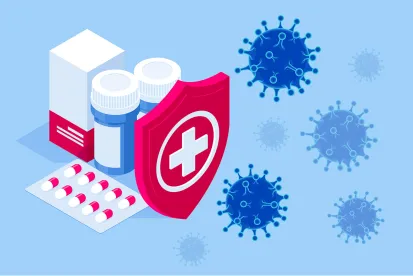Incident Response Tip: Responding to a COVID-19 Incident
The COVID-19 pandemic remains a health crisis in the United States and presents many unique challenges for employers. Many employers have already experienced COVID-19 cases among employees, while others may face such challenges as cases of the virus continue to rise. Though unique in some respects, the response to a COVID-19 incident has parallels to an industrial accident response, which involves developing and timely deploying the right resources.
Every incident, be it a fire, injury, or a government inspection and issuance of a citation involves four key elements of response: (1) the immediate response; (2) the extended response; (3) compliance and prevention; and (4) preparedness/lessons learned to improve. These response elements apply equally to a COVID-19 incident.
Facility managers and staffs are trained and prepared for responding to incidents such as fires or injuries; applying some of the same process in the context of COVID-19 can work well, even where handling these situations requires adjustment. In every crisis, the response needs to be tailored, and COVID-19 incidents are no different.
Examples of how a COVID-19 response needs to be tailored include initial investigation and determination of whether a COVID-19 case was work-related (which can be extremely difficult), identifying close contacts, identifying the agencies to whom notifications must be provided, and contact tracing for potentially exposed employees and implementing isolation protocols.
When confronting a COVID-19 incident, follow these useful tips to help minimize liability and potential for receiving a citation.
-
Familiarize yourself with Government Regulations and Guidance.
In the context of COVID-19, the Occupational Safety and Health Administration (OSHA) has issued FAQ’s regarding its reporting requirements. In addition to ensuring federal OSHA compliance, employers must follow various states and local agencies that have their own guidance and requirements.
The greatest exposure is sometimes not the incident itself but whether you follow the regulations and guidance for reporting and responding to the incident. That’s true for a major chemical release from your operations and a COVID-19 incident, alike. When the crisis emerged, several federal and state agencies provided guidance documents to companies on how to address potential cases of COVID-19. Like the crisis, the guidance is continually evolving. The government continues to update its approach and has even offered tailored guidance to specific industries. Following the agency guidance will put a facility in a much stronger compliance position when faced with a compliance inspection. It should be noted that since the start of the COVID-19 pandemic through Dec. 3, 2020, the U.S. Department of Labor’s Occupational Safety and Health Administration (OSHA) has proposed penalties totaling $3,504,345 from inspections related to COVID-19.
While OSHA has yet to issue formal workplace standards, some states have adopted emergency temporary standards in response to COVID-19, which carry the force of law and include comprehensive worker safety protections. In addition to these, separate executive orders have been issued by some governors, cities, and counties, which address various issues like mandatory face coverings, capacity limits and quarantine and exclusion requirements for employees with COVID-19 symptoms or exposures.
-
Consider Whether Government Notifications Are Required
Understand requirements for reporting employee COVID-19 cases to OSHA and state agencies. In the FAQs, OSHA defines a “work-related incident” as “an exposure to SARS-CoV-2 in the workplace.” In practice, determining whether a workplace exposure occurred is difficult. Given the data about asymptomatic spread and the multitude of potential infection sources employees encounter in daily life, it is almost impossible to pinpoint the source of an employee’s infection. OSHA’s guidance requires employers to consider conditions in the workplace, as well as potential alternative infection sources, to determine work-relatedness. An employer is only required to report a case of COVID-19 among its employees if it results in hospitalization or death, and the evidence indicates that it is more likely than not the exposure occurred at work.
Under the agency’s regulations, employers must contact OSHA to report certain serious work-related injuries and illnesses, such as fatalities and in-patient hospitalizations. Employers have eight hours to report a work-related fatality that occurs within 30 days of the work-related incident (i.e., event or exposure) precipitating it. Employers also have 24 hours to report an in-patient hospitalization if the hospitalization occurs within 24 hours of the work-related incident that caused it. In practice, it is extremely unlikely that an employee will be hospitalized within 24 hours of a work-related COVID-19 exposure because of the incubation period for the virus. As a result, a federal OSHA reporting obligation related to COVID-19 is likely to arise only if an employee dies of the virus within 30 days of a work-related exposure.
Employers should also check state local guidance to determine if there are other investigation, reporting, or recording obligations triggered by a COVID-19 incident. For example, in California, AB 685 took effect on January 1, 2021 and imposes obligations for employers to quickly notify employees of exposures, public health officials of outbreaks in the workplace.
Finally, recognize that if an employee is out with COVID-19 or quarantined, other government obligations, like environmental reporting may fall by the wayside in their absence. Develop a plan to ensure your ongoing government reporting obligations are being met, even those not COVID-19-related. Having an employee out due to COVID-19 is likely not going to serve as an acceptable excuse for environmental noncompliance.
-
Do the Investigation
To comply with OSHA requirements, employers should ensure their sites are investigating positive COVID-19 determinations in a timely manner to identify any work-related factors and to identify close contacts. This will protect employees and comply with OSHA requirements.
In determining whether an employer has complied with this obligation and made a reasonable determination of work-relatedness, OSHA has instructed its Compliance Safety and Health Officers (CSHOs) to take into account the reasonableness of the employer’s investigation into work-relatedness. According to OSHA, it is sufficient in most circumstances for the employer, when it learns of an employee’s COVID-19 illness, (1) to ask the employee how he believes he contracted the COVID-19 illness; (2) while respecting employee privacy, discuss with the employee his work and out-of-work activities that may have led to the COVID-19 illness; and (3) review the employee’s work environment for potential SARS-CoV-2 exposure.
-
Meet Requirements for Identifying and Notifying Potentially Affected Employees
As part of the investigation, additional employee cases and close contacts (within six feet for fifteen minutes or more) should be identified in accordance with the regulations and guidance. The facility will then need to consider testing or alternative methods (e.g., contact tracing or quarantining) to control the outbreak.
The CDC Guidance for Business and Employers recommends employers determine which employees may have been exposed to the virus and inform employees of their possible exposure to COVID-19 in the workplace. Confidentiality of employees with suspected or confirmed COVID-19 infection is required by the Americans with Disabilities Act (“ADA”) and Health Insurance Portability and Accountability Act (“HIPAA”).
-
Review and Update the Facility COVID-19 Plan to Apply Lessons Learned and Improve
OSHA has developed guidance for preparing workplaces for COVID-19. The plan should include sanitation practices, physical distancing, individual control measures, screening, and other incidental practices to prevent the spread amongst workers. Upon completion of an incident investigation, the facility should update the plan as needed to prevent further cases.
Employers should also check state requirements for having a written plan. States such as California require that employers implement a site-specific written COVID-19 prevention program to address COVID-19 health hazards, correct unsafe or unhealthy conditions and provide face coverings. Cal/OSHA has authority to issue an Order Prohibiting Use (OPU) to shut down an entire worksite or a specific worksite area that exposes employees to an imminent hazard related to COVID-19.
Conclusion
COVID-19 presents unique challenges to employers responding to incidents because of the difficulty in determining the source of infection, agency notification and attention, contact tracing, employee notification, testing, control measures, and return to work. Like any incident, COVID-19 incident response should focus on: (1) the immediate response by considering the need to make required agency notifications and dealing with the immediate employee concerns including contact tracing; (2) the extended response by conducting an incident investigation; (3) compliance and prevention by conducting testing or implementing isolation protocols; and (4) preparedness/lessons learned to improve by reviewing and updating the facility’s COVID-19 plan. Employers who work quickly and diligently to respond to a COVID-19 incident will reap the benefits of minimizing regulatory scrutiny, protecting employees and complying with legal reporting and notification requirements. They should also regularly check local, state, and federal guidance to determine if there are new or revised investigation, reporting, or recording obligations triggered by a positive COVID-19 case.




 />i
/>i
